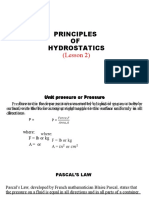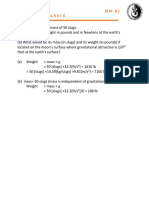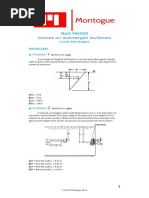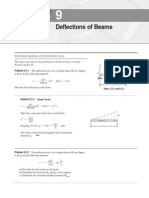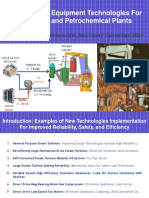Chapter 6
Uploaded by
Victoria JungChapter 6
Uploaded by
Victoria Jung6
TORSION
OBJECTIVES:
This chapter starts with torsion theory in the circular cross section
followed by the behaviour of torsion member. The calculation of
the stress stress and the angle of twist will be also showed here.
Lastly, the topics that include the members having noncircular
cross sections will be discussed. The examples and exercises will
be included to better understanding.
5.1 Introduction
Torsion refers to the twisting of a structural member that is loaded by
couples or torque. It will produce rotation about the members longitudinal
axis. Couples that produce twisting of a bar are called torques, twisting
couples or twisting moments and may be represented in several ways.
The example of shafts;
a) Rotating Machinery; Propeller shaft, Drive shaft
b) Structural Systems; Landing gear strut, Flap drive mechanism
Figure 6.1: Example of driving shaft
Mechanics of Materials 177
5.2 Torsion theory of circular cross section
Figure 6.2 : The circular cross section
Shaft connecting gears and pulleys are a common application involving
torsion members. To examine the stress and deformation of a torsion
member, a prismatic bar with a circular cross section that is twisted by
torques, T acting at the ends will be considered as shown in Figure 6.2.
(a) Before deformation
(b) After deformation
Figure 6.3: Deformation of bar
To better understand the behaviour of a torsion member, superimpose a
grid on the surface of shaft and observe the deformation of the shaft as a
result of the applied torque, T. Hold the left end of the bar fixed in
position. When a bar or shaft of circular section is twisted by moment, its
Mechanics of Materials 178
called pure tension and the deformed element shown in Figure 6.3 are said
to be in a state of pure shear.
Referring to Figure 6.3 and 6.4, several
characteristics of torsional loading on the
circular prismatic bar is observed;
1. The longitudinal axis of the shaft
remains straight.
2. The shaft does not increase or
decrease in length.
3. Radial lines remain straight and
Figure 6.4 radial as the cross section rotates.
4. Cross sections rotate about the
axis of the member.
The warping does not occur in circular section. The theory of torsion with
the circular section is relatively simple.
5.2.1 Shear stress in circular section, (tau)
Tr
J
Where;
: Shear stress in the shaft if max=maximum shear stress occurs at the
outer surface @ tegasan ricih. (N/m2)
J : Polar moment of inertia of the cross sectional area @ moment
sifatekun kutub (m4)
T : Applied torque acting at the cross section (Nm)
r : Radius of the shaft (m)
Mechanics of Materials 179
5.2.2 Types of circular section
5.2.3 Angles of twist, ( phi ) @ sudut piuhan
TL
JG
Where;
= angle of twist (radians)
T = applied torque
L = length of member
G = shear modulus of material/ modulus of rigidity@modulus
ketegaran (N/m2)
J = polar moment of inertia
5.2.4 Power transmission
Circular bars or shafts are commonly used for transmission of power.
From design stand point, it is necessary for the shaft to be strong enough to
transmit power safely without exceeding the shaft material's elastic limit.
Power is defined as the work performed per unit of time. The work
transmitted by a rotating shaft equals to the torque applied times the angle
of rotation.
Work = Torque x Angular Displacement
Mechanics of Materials 180
Power = d/dt (Work)
If torque is not a function of time, then the equation for power simply
becomes:
P=T
Where;
is the angular velocity of the shaft (rad/s)
T : Applied torque acting at the cross section (Nm)
P : Power (W)(1W = 1 Nm/s)
For machinery, the frequency of a shafts rotation, f is often reported. This
is a measure of the revolutions number@cycles of the shaft.
P = 2 f T
Where;
f : frequency (Hz @ hertz) (1 Hz = 1 cycle/s)
: 2 f
It is important that we use consistent units for P, T, and . Power is
commonly specified in horsepower, HP. Angular velocity is usually given
in revolutions per minute or RPM. It should then be converted to rad/sec.
To do this multiply the value in RPM by 2 and divide by 60.
EXAMPLE 6.1
Determine the maximum torque of a hollow circular shaft with inside diameter of
60mm and an outside diameter of 100mm without exceeding the maximum
shearing stress of 70MPa.
Solution;
Given;
di = 60mm, do = 100mm
max = 70MPa
J (100 4 604 ) 8.55x106 mm4
32
Mechanics of Materials 181
Tmax r
max
J
max J
Tmax
r
(70 x10 6 )(8.55 x10 6 )
11.97kNm
0.05
Remember: max=maximum shear stress occurs at the outer surface/radius.
EXAMPLE 6.2
A hollow steel shaft has an outside diameter of 150mm and an inside diameter
100mm. The shaft is subjected to a torque of 35kNm. The modulus of rigidity for
the steel is 80GPa. Determine;
a) the shearing stress at the outside surface of the shaft.
b) the shearing stress at the inside surface of the shaft.
c) the magnitude of the angle of twist in a 2.5m length.
Solution;
J (150 4 100 4 ) 39.89 x106 mm4
32
a) the shearing stress at the outside surface of the shaft.
Tr
out
J
35 x103 (0.075)
65.81MPa
39.89 x10 6
b) the shearing stress at the inside surface of the shaft
Tr
in
J
35 x103 (0.05)
43.9 MPa
39.89 x10 6
c) the magnitude of the angle of twist in a 2.5m length.
TL
JG
35x103 (2.5)
0.027rad
80 x109 (39.89 x10 6 )
Mechanics of Materials 182
EXAMPLE 6.3
A 3m long hollow steel shaft has an outside diameter of 100mm and an inside
diameter of 60mm. The shear modulus of steel is 80GPa. The maximum shearing
stress in the shaft is 80MPa and the angular velocity is 200rpm. Determine;
a) the power being transmitted by the shaft.
b) the magnitude of the angle of twist in the shaft.
Solution;
J (1004 604 ) 8.55x106 mm4
32
Tmax r
max
J
max J
Tmax
r
(80 x106 )(8.55 x10 6 )
13.68kNm
0.05
a) the power being transmitted by the shaft.
From the previous notes stated that angular velocity is usually given in revolutions
per minute or RPM. It should then be converted to rad/sec. To do this multiply the
value in RPM by 2 and divide by 60.
2T 2 (200)(13.68 x103 )
P Hp(horse power ) 286.55kW
60 60
b) the magnitude of the angle of twist in the shaft.
TL
JG
13.68 x103 (3)
0.06rad
80 x109 (8.55x10 6 )
Mechanics of Materials 183
EXAMPLE 6.4
A solid circular steel shaft 1.5m long transmits 200kW at a speed of 400rpm. If
the allowable shearing stress is 70MPa and the allowable angle of twist is 0.045
rad. The shear modulus of steel is 80GPa.
a) the minimum permissible diameter for the shaft.
b) the speed at the same power that can be delivered if the stress is not exceed
50MPa in a diameter of 75mm.
Solution;
Given L =1.5m
P = 200kW
= 400 rpm
allow = 70MPa
allow = 2.6 or 0.045 rad
G = 80GPa
a)
P T
2T
60
2 (400)T
200 x103
60
T 4.77kNm
Tr TL
i) allow ii) allow
J JG
d 4.77 x103 (1.5)
4.77 x103 0.045
2 d 4
allow (80 x109 )
d 4 32
32 9.109 x10 7
=
2385d d4
70 x106
0.0982d 4 d 0.067mm @ 67.1mm
70 x106 d 3 24287.2
d 0.07m @ 70.27mm
Pick d = 70.27mm
b) Given d = 75mm
d 4 (75) 4
J 3.11x106 mm 4
32 32
Tr
J
Mechanics of Materials 184
T (0.0375)
50 x106
3.11x10 6
T = 4.15kNm
P T
2T
60
2 (4.15x103 )
200 x103
60
= 461rpm
EXERCISE 6.1
A hollow circular shaft has an outside diameter D 2 of 100mm and an inside
diameter D1 of 60mm. Given the maximum allowable shearing stress is 55
N/mm2.
a) Show that its polar moment of inertia , J is 8.55x10 6 mm4.
b) Calculate the maximum torque, T that can applied to the shaft
c) Determine the shear stress at the inner surface of the hollow shaft
EXERCISE 6.2
A tubular shaft having an inner diameter of 30mm and outer diameter of 42mm is
to be used to transmit 90kW of power. Determine the frequency of rotation of the
shaft so that the shear stress will not exceed 50MPa.
[Ans: f = 26.62Hz]
Mechanics of Materials 185
5.3 Composite Bars
A B C
Shaft 1 Shaft 2
To solve the problem of combined/composite shaft;
a) T = Tshaft 1 + Tshaft 2 + ..Tshaft n
n = number of shaft
b) 1 2
TL
c)
JG
EXAMPLE 6.5
The composite bars with the different material is subjected to the torque is shown
in figure. Determine the maximum shear stress and the position. Determine the
angle of twist at C.
10kNm
A B C
4kNm
BAR r (mm) G(Pa)
2m 0.3m AB 50 3x1010
BC 25 8x1010
Solution;
d 4 (1002 )
J AB 9.82 x106 mm4
32 32
d 4 (502 )
J BC 0.62 x106 mm4
32 32
10kNm
A B C T = outward ()
4kNm
T = inward ()
2m 0.3m Or applied Right Hand
Rule
Mechanics of Materials 186
10kNm
A B C
6kNm 4kNm
TA
2m 0.3m
6kNm
TAB = 6kNm (T)
6kNm TBC = 4kNm(C)
10kNm
Maximum shear stress;
T r 6 x106 (50)
AB AB AB 30.55N / mm2
J AB 9.82 x106
TBC rBC 4 x106 (25)
BC 6
161.3N / mm2
J BC 0.62 x10
The maximum shear stress occurs in the bar of BC.
Angle of twist at the end of C;
TL TL TL
JG JG AB JG BC
(6 x106 )(2000) ( 4 x106 )(300)
0.0158rad
9.82 x106 (3x10 4 ) 0.62 x106 (8 x104 )
Mechanics of Materials 187
EXERCISE 6.3
The horizontal shaft AD is attached to a fixed support at D and is subjected to
point torques as shown in figure. A 40mm diameter hole has been drilled into the
portion CD of the shaft. By assuming that the entire shaft is made of steel and G
=70GN/m2, determine the angle of twist at end A.
5.4 Torsion of non-cylindrical member
Generally, we deal with axisymmetric bodies and the shear strain is linear
through the entire body. However, non-circular cross-sections are not
axisymmetric causing complex behaviors, which may cause bulging or
warping when the shaft is twisted.
Figure 6.5: Condition of bulging of non-circular shaft
Mechanics of Materials 188
The mathematics is beyond the scope of the course, however there are
empirical formulas for various shapes.
Table 6.1: Formula for various shapes
EXAMPLE 6.6
The aluminum shaft shown in figure has a cross sectional area in the shape of an
equilateral triangle. Determine the largest torque, T that can be applied to the end
of the shaft if the allowable shear stress,
allow is = 56MPa and the angle of twist at
its end is restricted to allow = 0.02 rad. Given Gal = 26GPa.
Mechanics of Materials 189
Solution;
By inspection, the type of shaft is equilateral triangle. Refer to Table 6.1,
20T
i) allow 3
a
20 T
56 N / mm2 3
40
T 179.2kNmm
46TL
ii) allow
a 4Gal
46T (1200mm) 46T (1.2m)
0.02rad or 0.02rad
N N
(40 4 mm)( 26 x103 ) (0.04 4 m)( 26 x109 )
mm 2 m2
T 24.12kNmm T 24.12 Nm
By comparison, the torque is limited due to the angle of twist.
T 24.12kNmm
5.5 Thin-walled Having Closed Cross Sections
Thin walled of noncircular shape are often used to construct lightweight
frameworks which is used in aircraft. In this section, we will analyze the
effects of applying a torque to a thin walled having a closed cross section.
The section does not have any breaks or slits along its length.
5.5.1 Shear flow, q.
Due the applied torque, T, shear stress is developed on the front face of the
element. Shear flow in a solid body is the gradient of a shear stress through
the body. Shear flow is the product of the tubes thickness and the average
shear stress. This value is constant at all points along the tubes cross
section. As a result, the largest average shear stress on the cross section
occurs where the tubes thickness is small.
q avg t
Mechanics of Materials 190
5.5.2 Average shear stress, ave
In non-circular thin walled shafts for closed segments. We assume that the
stress is uniformly distributed across the thickness and that we can assume
an average shear stress. The average shear stress in the body is;
T
ave
2tAm
where,
ave - average shear stress
t - the thickness of the shaft at the point of interest
Am - mean area enclosed within the boundary of the centerline
of the shaft thickness.
T - the applied torque
Am is shown in shaded area.
The relationship between shear stress, and torque, T;
ds
dF
ave
t h
ave
T dT h(dF )
Mechanics of Materials 191
h ( avet ds )
avet h ds
2 avet d Am
2 avet Am
T
ave
2tAm
Since q avg t , we can determine the shear flow throughout the cross
section using the equation;
T
q
2 Am
5.5.3 Angle of twist,
This angle can be determined by using the energy method. The angle given
in radians, can be expressed as;
TL ds
2
4 Am G t
Here the integration must be performed around the entire boundary of the
tubes cross sectional area.
where,
t - thickness of the interior segment
L - length of the section
G - modulus of rigidity of the section/shear modulus
Mechanics of Materials 192
EXAMPLE 6.7
The tube is made of bronze and has a rectangular section as shown in figure. If it
is subjected to the two torques;
a) determine the average shear stress in the tube at points A and B.
b) determine the angle of twist at end C. Given G = 38GPa.
Solution;
a)
25Nm
60Nm
C D E
60Nm TCD = 60Nm (T)
60Nm
25Nm 35Nm TDE = 35Nm (T)
60Nm
OR
The tube is subjected to the two torques at C and D. The
free body diagram is shown in figure. The internal torque
is 35 Nm.
T= T
60 = 25 ----> to balance (60-25)=35Nm
Mechanics of Materials 193
The area, Am; Am (0.035)(0.057) 0.002m 2
57mm
The shaded area = Am
35mm
The average shear stress at point A with t A = 5mm;
T
ave
2tAm
35
A 1.75MPa
2(0.005)(0.002)
The average shear stress at point B with t B = 3mm;
35
B 2.92 MPa
2(0.003)(0.002)
b)
The internal torques in regions DE and CD are 35Nm and 60Nm, respectively.
TL ds TL ds
2 2
4 Am G t CD 4 Am G t DE
60(0.5) 57mm 35mm
9
2 2
4(0.002 )(38 x10 ) 5mm 3mm
2
Mechanics of Materials 194
35(1.5) 57mm 35mm
9
2 2
4(0.002 )(38 x10 ) 5mm 3mm
2
30
22.8 23.33 52.5 22.8 23.33
608000 608000
3 3
2.28 x10 3.98 x10
6.26 x10 3 rad
EXAMPLE 6.8
A square aluminum tube has the dimensions as shown in figure.
a) determine the average shear stress in the tube at point A if it is
subjected to a torque of 85Nm.
b) compute the angle of twist due to this loading. Given G al = 26GPa.
1.5m
Solution;
a)
The area, Am; Am (50)(50) 2500mm2
50mm
The shaded area = Am
T 50mm
85x103
avg 1.7 N / mm2
2tAm 2(10)(2500)
Mechanics of Materials 195
Since t is a constant because of the square tube, the average shear stress is the
same at all points on the cross section.
b)
Angle of twist;
TL ds
2
4 Am G t
(85x103 )(1500) 50mm
4
4(2500) 2 (26 x103 ) 10mm
1.962 x10 4 (20)
3.92 x10 3 rad
Here, the integral represents the length around the centerline boundary of the tube.
EXERCISE 6.4
If a =25mm and b = 15mm, determine the maximum shear stress in the circular
and elliptical shafts when applied torque is T=80Nm. By what percentage is the
shaft of circular section more efficient at withstanding the torque than the shaft of
elliptical cross section?
[Ans: b) (max)c = 3.26MPa, (max)e = 9.05MPa, 178%]
Mechanics of Materials 196
EXERCISE 6.5
The square shaft is used at the end of a drive cable in order to registrar the rotation
of the cable on a gauge. If it has the dimensions shown and is subjected to a torque
of 8Nm, determine the shear stress in the shaft at point A.
Mechanics of Materials 197
TUTORIAL 5
1.
a) If the shearing stress is not exceed 70 N/mm2, determine the maximum
torque that may be transmitted by a solid circular shaft of diameter
98.5mm and length of 1.62m. Take shear modulus of steel is 80kN/mm2.
b) The square thin walled tube is subjected to a torque of 150Nm. Determine
the average shear stress in the tube if the mean dimension a = 200mm.
Each side has a thickness of t = 3mm.
[Ans: a) ave = 1.25MPa]
2.
a) A hollow circular shaft has an outside diameter D 2 of 100mm and an
inside diameter D1 of 75mm. Show that its polar moment of inertia , J is
6.71x106 mm4. Given the maximum allowable shearing stress is 65
N/mm2. Calculate;
i) the maximum torque, T that can applied to the shaft.
ii) the shear stress at the inner surface of the hollow shaft.
b) A continuous circular shaft is made of two segments AB and BC with
diameters 205mm and 105mm respectively. The shaft is fixed at the end A
and subjected to anticlockwise torques of 60kNm at B and 30kNm at C as
shown in figure. Take G = 80kN/mm2. Find the total angle of twist at the
end C.
Mechanics of Materials 198
3.
a) The figure shows the crosssectional of a hollow shaft. Prove the torsion
equation for concentrically hollow circular shafts is given by expression;
T max
J R2
where;
T = applied torque
R2 = outer radius of the shaft
R1 = inner radius of the shaft
max= shear stress at outer radius R2
J = polar moment of inertia
dr = an elementary ring of a thickness
at r, radius.
b) A hollow steel shaft is subjected to receive a torque of 30kNm. The shaft
has an outside diameter of 150mm and inside diameter of 100mm. The
Modulus of Rigidity for the steel is 80GPa. Determine;
i) the shear stress on the outside surface of the shaft.
ii) the shear stress on the inside surface of the shaft.
iii) the maximum shear stress of the shaft.
iv) the twist angle for a 3.5m length of the shaft.
4.
a) Discuss THREE (3) assumptions to be made in the derivation of torsion
equation for a circular shaft.
b) A steel circular bar in torsion consists of two parts, as shown in Figure
Q4(a). Part AB has diameter 60 mm and length 1 m, and part BC has
diameter 30 mm and length 1.2 m. What is the allowable torque T if the
angle of twist between the ends of the bar is not to exceed 0.035 radians
and the shear stress is not to exceed 30 MPa? Assume Modulus of
Rigidity, Gsteel = 80 GPa.
c) A torque of 5 kNm is applied to the rectangular section shown in Figure
Q4(b). Determine the wall thickness t so as not to exceed a shear stress of
80 MPa.
Mechanics of Materials 199
60 mm 30 mm
T A B C T
1m 1.2 m
Figure Q4(a)
50 mm
100 mm
Figure Q6(c)
(FINAL EXAM SEM II 2007/2008 UTHM)
5.
A hollow section as shown in Figure Q5 is subjected to a torque of 100Nm at
point A.
a) Sketch a thin wall tube to show elements subjected to torsion.
b) Derive the equation of average shear stress, ave in terms of internal torque,
T, the thickness of hollow section, t and the mean area enclosed within the
boundary of the centre line of the thickness of the hollow section.
c) Determine the average shear stress in the hollow section at point A.
Mechanics of Materials 200
d) Calculate the angle of twist assuming G = 200GPa.
A
20
L = 3m
200
20 All units in mm
150
Figure Q5
(FINAL EXAM SEM I 2007/2008 UTHM)
6.
a) Determine the torque T that can be applied to the rectangular tube if the
average shear stress is no exceed 85MPa. The mean dimensions of the tube are
shown and the tube has thickness of 3mm.
50mm
100mm
[Ans: a) T = 2.55kNm]
b) The solid compound rod made of three different materials carried
the two torques as shown in Figure Q3. Given Galuminum = 28GPa, Gbronze =
35GPa dan Gsteel = 83GPa. (Answer in unit N/mm2 ).
i) Calculate the maximum shear stress in each material.
ii) Find the angle of rotation of the free end of the rod.
Mechanics of Materials 201
5 kN.m
Aluminum 2 kN.m
Steel Bronze
100 mm 75 mm
3m 2m 1.5 m
Mechanics of Materials 202
You might also like
- Case Study of The Changi East Land Reclamation Project SingaporeNo ratings yetCase Study of The Changi East Land Reclamation Project Singapore13 pages
- Case Study of The Changi East Land Reclamation Project SingaporeNo ratings yetCase Study of The Changi East Land Reclamation Project Singapore13 pages
- Lesson 16 Stress Transformation (Mohr Circle)No ratings yetLesson 16 Stress Transformation (Mohr Circle)4 pages
- Internal Forces and Moments Solved ProblemsNo ratings yetInternal Forces and Moments Solved Problems19 pages
- Be First Year Engineering Semester 1 2019 December Engineering Mechanics Emrev 2019'c' SchemeNo ratings yetBe First Year Engineering Semester 1 2019 December Engineering Mechanics Emrev 2019'c' Scheme43 pages
- I Coplanar Concurrent Force Systems: Mass (M)No ratings yetI Coplanar Concurrent Force Systems: Mass (M)21 pages
- 11 Midtermexam Fluid-Mechanics July-8-2022 ProblemsNo ratings yet11 Midtermexam Fluid-Mechanics July-8-2022 Problems4 pages
- EMM 213 Strength of Materials: Axial DeformationNo ratings yetEMM 213 Strength of Materials: Axial Deformation29 pages
- Quiz FM102: Forces On Submerged SurfacesNo ratings yetQuiz FM102: Forces On Submerged Surfaces15 pages
- Mechanics of Deformable Bodies Midterm QuizNo ratings yetMechanics of Deformable Bodies Midterm Quiz6 pages
- Combined Loadings: Thin-Walled Pressure VesselsNo ratings yetCombined Loadings: Thin-Walled Pressure Vessels31 pages
- Fluid Mechanics and Machinery Question BankNo ratings yetFluid Mechanics and Machinery Question Bank8 pages
- Handout (1) Minggu 03 - Normal Dan Polar Examples and Problem SetNo ratings yetHandout (1) Minggu 03 - Normal Dan Polar Examples and Problem Set18 pages
- CE 302-Lecture-5 - Stress and Strain Under Axial Loading-Generalized Hooke's LawNo ratings yetCE 302-Lecture-5 - Stress and Strain Under Axial Loading-Generalized Hooke's Law25 pages
- DAY 1 - Statics, Dynamics, Strength of Materials100% (1)DAY 1 - Statics, Dynamics, Strength of Materials20 pages
- 03 - Rotational Motion - Theory & Example Module-2No ratings yet03 - Rotational Motion - Theory & Example Module-232 pages
- CE Board May 2021 - Engineering Mechanics - Set 1No ratings yetCE Board May 2021 - Engineering Mechanics - Set 13 pages
- Numerical Methods and Implementation in Geotechnical Engineering – Part 1From EverandNumerical Methods and Implementation in Geotechnical Engineering – Part 1No ratings yet
- Torsion of Circular Members - Lesson - Notes-1No ratings yetTorsion of Circular Members - Lesson - Notes-115 pages
- Hydraulics Topic 6 Hydraulic Machinery PDFNo ratings yetHydraulics Topic 6 Hydraulic Machinery PDF48 pages
- Investigation of The Relationship Between Load and Loss Factors For A Brazilian Electric Utility (Oliveira2006) PDFNo ratings yetInvestigation of The Relationship Between Load and Loss Factors For A Brazilian Electric Utility (Oliveira2006) PDF6 pages
- Cuestionario Modelos Atomicos y Lineas Espectrales (1)No ratings yetCuestionario Modelos Atomicos y Lineas Espectrales (1)3 pages
- PDF Reliability New Technologies For Rotating Equipment 1599820470No ratings yetPDF Reliability New Technologies For Rotating Equipment 159982047024 pages
- Liquid Drop Model and Bohr-Wheeler Theory of Nuclear Fission100% (1)Liquid Drop Model and Bohr-Wheeler Theory of Nuclear Fission6 pages
- An Overview of National Climate Change Strategies and Priorities in Papua New GuineaNo ratings yetAn Overview of National Climate Change Strategies and Priorities in Papua New Guinea10 pages
- Procedure For Sectional Field Hydrotest For Di Pipes: Jainco Buildcon Pvt. Ltd.No ratings yetProcedure For Sectional Field Hydrotest For Di Pipes: Jainco Buildcon Pvt. Ltd.11 pages
- Solar Energy Can Be A Health Hazard: Keywords: Solar Power, Wind Power, Inverters, Dirty ElectricityNo ratings yetSolar Energy Can Be A Health Hazard: Keywords: Solar Power, Wind Power, Inverters, Dirty Electricity4 pages
- Kendriya Vidyalaya Tehran Split Up Syllabus 2011 - 2012 Class Xii Subject - Physics Month Name of The Topic Detailed Split Up SyllabusNo ratings yetKendriya Vidyalaya Tehran Split Up Syllabus 2011 - 2012 Class Xii Subject - Physics Month Name of The Topic Detailed Split Up Syllabus5 pages
- (Springer Series in Materials Science 200) Ilya V. Shadrivov, Mikhail Lapine, Yuri S. Kivshar (Eds.) - Nonlinear, Tunable and Active Metamaterials-Springer International Publishing (2015) PDFNo ratings yet(Springer Series in Materials Science 200) Ilya V. Shadrivov, Mikhail Lapine, Yuri S. Kivshar (Eds.) - Nonlinear, Tunable and Active Metamaterials-Springer International Publishing (2015) PDF333 pages
- Vibration: Free Vibration of Single Degree of Freedom SystemsNo ratings yetVibration: Free Vibration of Single Degree of Freedom Systems36 pages
- Relay Module - PLC-RSC-24DC/21 - 2966171: Your AdvantagesNo ratings yetRelay Module - PLC-RSC-24DC/21 - 2966171: Your Advantages23 pages
- Degassing Spray Technology Sulfur Recovery - MDRNo ratings yetDegassing Spray Technology Sulfur Recovery - MDR3 pages
- Case Study of The Changi East Land Reclamation Project SingaporeCase Study of The Changi East Land Reclamation Project Singapore
- Case Study of The Changi East Land Reclamation Project SingaporeCase Study of The Changi East Land Reclamation Project Singapore
- Be First Year Engineering Semester 1 2019 December Engineering Mechanics Emrev 2019'c' SchemeBe First Year Engineering Semester 1 2019 December Engineering Mechanics Emrev 2019'c' Scheme
- 11 Midtermexam Fluid-Mechanics July-8-2022 Problems11 Midtermexam Fluid-Mechanics July-8-2022 Problems
- Handout (1) Minggu 03 - Normal Dan Polar Examples and Problem SetHandout (1) Minggu 03 - Normal Dan Polar Examples and Problem Set
- CE 302-Lecture-5 - Stress and Strain Under Axial Loading-Generalized Hooke's LawCE 302-Lecture-5 - Stress and Strain Under Axial Loading-Generalized Hooke's Law
- 03 - Rotational Motion - Theory & Example Module-203 - Rotational Motion - Theory & Example Module-2
- Numerical Methods and Implementation in Geotechnical Engineering – Part 1From EverandNumerical Methods and Implementation in Geotechnical Engineering – Part 1
- Investigation of The Relationship Between Load and Loss Factors For A Brazilian Electric Utility (Oliveira2006) PDFInvestigation of The Relationship Between Load and Loss Factors For A Brazilian Electric Utility (Oliveira2006) PDF
- Cuestionario Modelos Atomicos y Lineas Espectrales (1)Cuestionario Modelos Atomicos y Lineas Espectrales (1)
- PDF Reliability New Technologies For Rotating Equipment 1599820470PDF Reliability New Technologies For Rotating Equipment 1599820470
- Liquid Drop Model and Bohr-Wheeler Theory of Nuclear FissionLiquid Drop Model and Bohr-Wheeler Theory of Nuclear Fission
- An Overview of National Climate Change Strategies and Priorities in Papua New GuineaAn Overview of National Climate Change Strategies and Priorities in Papua New Guinea
- Procedure For Sectional Field Hydrotest For Di Pipes: Jainco Buildcon Pvt. Ltd.Procedure For Sectional Field Hydrotest For Di Pipes: Jainco Buildcon Pvt. Ltd.
- Solar Energy Can Be A Health Hazard: Keywords: Solar Power, Wind Power, Inverters, Dirty ElectricitySolar Energy Can Be A Health Hazard: Keywords: Solar Power, Wind Power, Inverters, Dirty Electricity
- Kendriya Vidyalaya Tehran Split Up Syllabus 2011 - 2012 Class Xii Subject - Physics Month Name of The Topic Detailed Split Up SyllabusKendriya Vidyalaya Tehran Split Up Syllabus 2011 - 2012 Class Xii Subject - Physics Month Name of The Topic Detailed Split Up Syllabus
- (Springer Series in Materials Science 200) Ilya V. Shadrivov, Mikhail Lapine, Yuri S. Kivshar (Eds.) - Nonlinear, Tunable and Active Metamaterials-Springer International Publishing (2015) PDF(Springer Series in Materials Science 200) Ilya V. Shadrivov, Mikhail Lapine, Yuri S. Kivshar (Eds.) - Nonlinear, Tunable and Active Metamaterials-Springer International Publishing (2015) PDF
- Vibration: Free Vibration of Single Degree of Freedom SystemsVibration: Free Vibration of Single Degree of Freedom Systems
- Relay Module - PLC-RSC-24DC/21 - 2966171: Your AdvantagesRelay Module - PLC-RSC-24DC/21 - 2966171: Your Advantages



